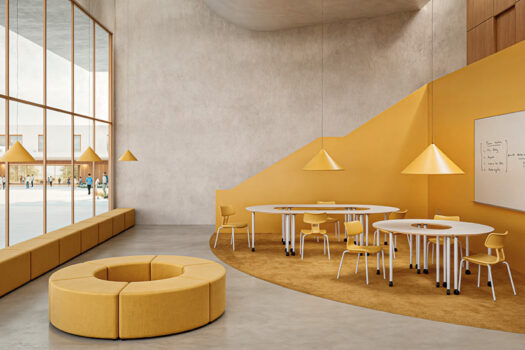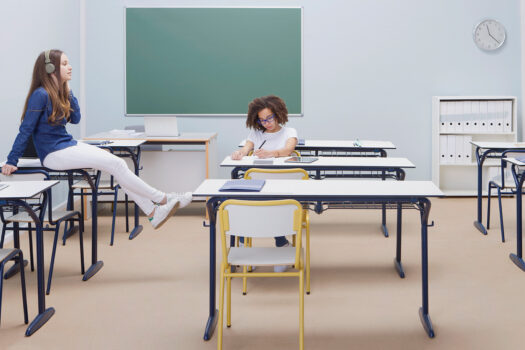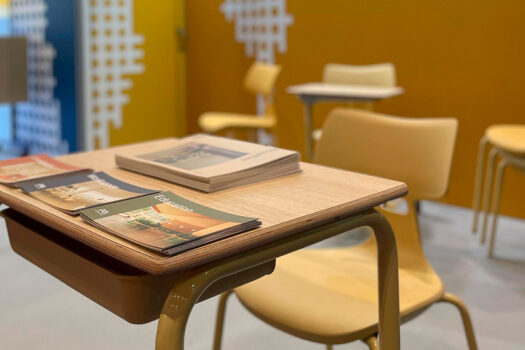Green is much more than just a shade within the color spectrum. In educational environments and offices, its use goes beyond aesthetics, influencing the concentration, creativity, and well-being of the people within it.
Its versatility and symbolism make it a key choice for transforming these spaces and enhancing their functionality.
Throughout this article, we will explore its impact on color psychology, its symbolism, different shades, and how its application influences the design of these environments.
Color as a tool to enhance creativity, comfort, and productivity
Color plays a fundamental role in human perception and behavior. Color psychology examines how different tones affect our emotions and performance.
In space design, the right choice of colors can influence productivity, comfort, and creativity.
Factors such as lighting, furniture arrangement, and the materials used play a crucial role in the perception of space, but color is one of the most powerful elements when it comes to influencing our emotions. The choice of color palette can make an environment feel stimulating, relaxing, welcoming, or even monotonous.

From Nature to the Office: How the Color Green Promotes Growth, Creativity, and Balance
Green has historically been a color rich in meaning and symbolism. It is the color of nature, life, and renewal, making it a tone that conveys freshness, tranquility, and stability.
In the educational field, green is associated with growth and learning. Its connection to nature makes it a color that symbolizes evolution, change, and progress—essential qualities for academic and cognitive development. Furthermore, its presence in classrooms and study spaces enhances concentration and information retention, providing a serene environment that helps reduce stress and mental fatigue.

In work environments and offices, green symbolizes balance and harmony. Its influence on workers' psychology is linked to emotional stability, creativity, and a sense of well-being. It is also associated with innovation and productivity, promoting a healthier and more stimulating environment for decision-making and problem-solving.
On a broader level, green has also become a symbol of sustainability and environmental awareness. Its use in interior design reinforces the connection to environmental values, conveying a message of responsibility and commitment to the planet. Spaces dominated by green are often perceived as healthier places that foster the physical and emotional well-being of their occupants.

Low curved soft seating – Actiflex®

Softseating modular curvo bajo, permite ofrecer una amplia variedad de formas, adaptables a diferentes espacios y actividades.
DISCOVERThe Versatility of the Green Color: Shades and Their Application in Different Environments
Green is not a single color, but a range of shades that have different effects on space design. Some of the main variations and their applications are:
🟩 Emerald Green: Elegant and sophisticated, it adds depth to meeting rooms and libraries.
🟩 Olive Green: With a more earthy base, it is ideal for break areas and common zones.
🟩 Mint Green: Softness and freshness at its best, suitable for preschool classrooms and collaborative workspaces.
🟩 Apple Green: Vibrant and full of energy, it helps energize classrooms and creative areas.
🟩 Forest Green: Deep and natural, it creates a relaxing atmosphere in study rooms and offices with high activity.

In summary, green is a color that has not only a visual impact but also emotional and psychological effects. Its presence in educational spaces can foster an environment of calm, concentration, and creativity. It is a color associated with nature, health, and well-being, making it an excellent choice for learning environments that aim to promote balance and productivity.
At Federico Giner, we help you incorporate green into your spaces. We know that this color not only adds an aesthetic touch but also supports the overall well-being of students and educators. Whether in soft and relaxing tones or more vibrant and energetic versions, green has the power to transform educational spaces into more pleasant and effective environments for learning.
Would you like to discover how our furniture can improve your space? Contact us, and we’ll guide you through the best options.
From idea to reality,
we make it possible
Preguntas frecuentes (FAQs)
How does the color green influence productivity in offices and educational environments?
The color green is known for its calming effects, which help reduce stress and mental fatigue. In offices and educational environments, it promotes concentration and creativity, fostering an environment conducive to performance and learning.
What shades of green are most recommended for different spaces?
Green has a wide range of shades, each with its own effects. Emerald green adds elegance and depth to meeting rooms, while mint green is perfect for collaborative workspaces or classrooms, creating a fresh and relaxing environment. Olive green, more earthy, is ideal for common and resting areas, while apple green brings energy and dynamism to creative spaces.
What are the benefits of the color green in classroom and office design?
Green, as a color associated with nature, promotes a healthy environment and stimulates creativity. In classrooms, it enhances concentration and learning, while in offices, it improves decision-making, fosters innovation, and creates more dynamic and productive spaces.
How can green reflect sustainability values in interior design?
Green is also a color associated with sustainability and environmental awareness. By incorporating this color into the design of offices and educational spaces, not only is a healthier environment created, but it also conveys a message of commitment to the environment, reinforcing values of responsibility and respect for the planet.





